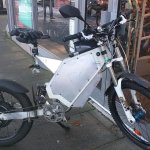There are threads about doing exactly this (perhaps minus the RF remote); i don't know if anyone ever implemented it, but the technical details are there, if you look around.
There's also discussion of the potential problems, such as that relays can chatter from vibration, and if this happens during a ride sufficiently to allow a short while in motion, it will blow up your controller and add significant plug-braking drag to the wheel, which could cause you loss of control. Or if the remote system somehow activated while riding; it would be even worse with all three phases shorted.
It will also blow up the controller if the shorting system is still activated and the thief manages to turn the system on and try to run the motor. They won't be able to ride away, but neither will you. (and if the controller failure is a complete shoot-thru it will short the battery itself out, which if your protections against that are inadequate could cause a battery fire and destroy the whole thing, as well as whatever is near it).
You can design it so that the controller is disconnected when the relay activates, but this means the relay has to carry the entire full-load worst-case phase currents, too, and that's a fairly big relay compared to what you need to just short the phases enough to make the wheel very hard to turn from a stop.
Instead, if you really want to lock the motor by phase shorting, I'd recommend using a motor-to-controller phase connection that requires a removable bridge connector, and the two halves of the on-bike are connectors that cannot plug into each other, and can't be connected via simple wire bridges stuck into the pins, should a thief know enough to be able to do that. That way you can remove that connector when you walk away from the bike, which leaves it unable to be driven by the controller. Then you can have a shorting plug to connect to just the motor side in it's place, that is wired to connect all three phases together.
They can still pick the bike up and walk away with it, or toss it in the back of a truck, van, SUV, etc., they do that with full-size motorcycles.
If they really want to steal it, they will, no matter what you do, other than having a human you trust guarding it, or never leaving it.
If you make it less desirable-looking, it may make them go to the next one over, but if it's the best target wherever it is, they'll go after it. There are a number of threads about anti-theft measures as well, of all types, from locks to uglification to stealth.
 got stolen
got stolen 


